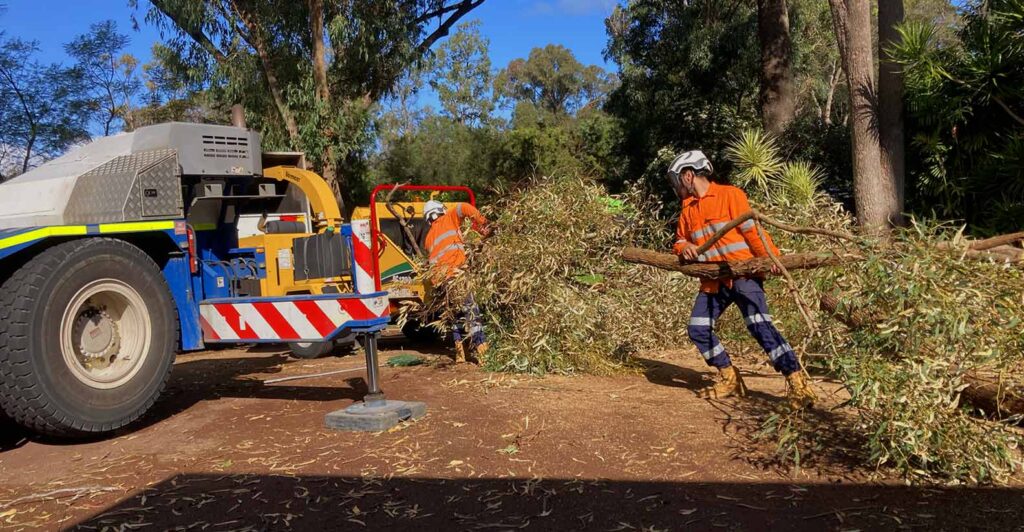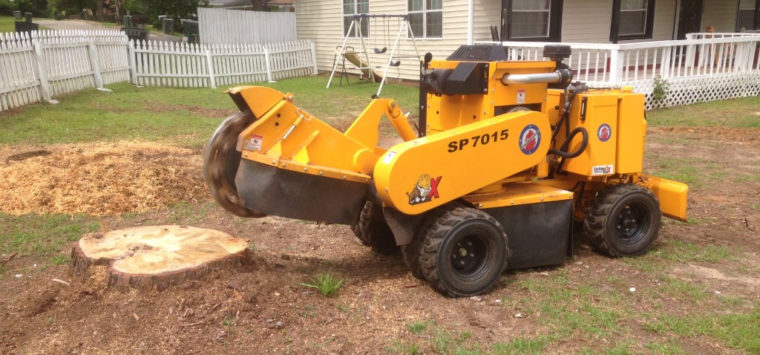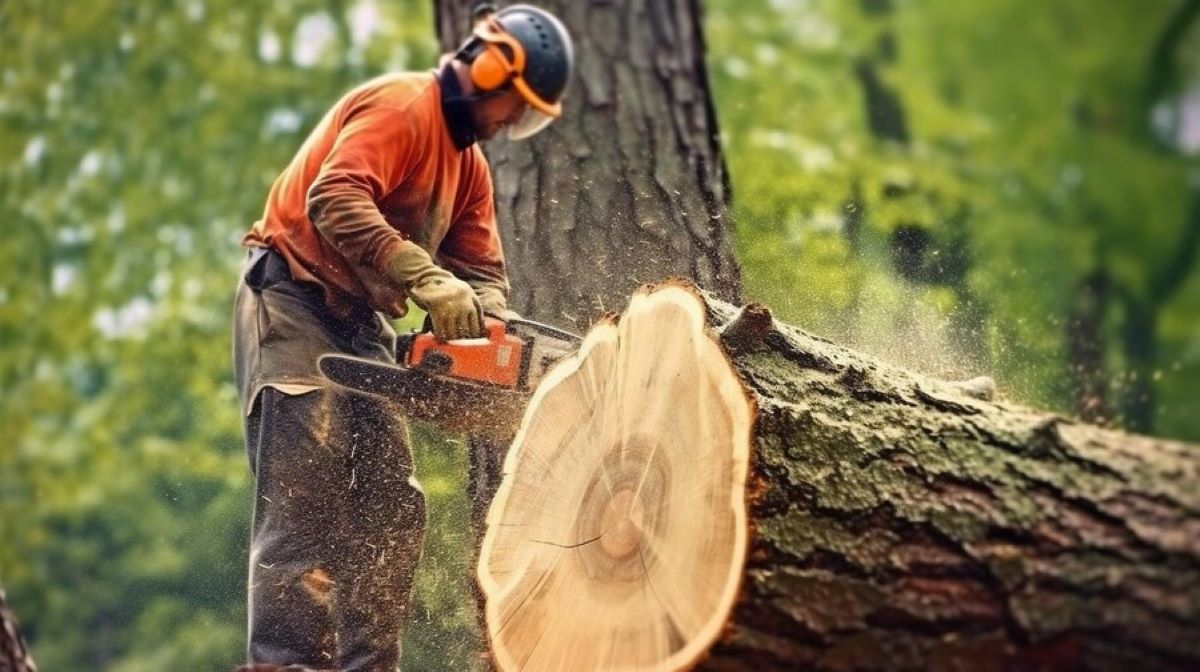What is Stump Grinding and Why is the Right Depth Important?
Stump grinding is a mechanical process that removes tree stumps by grinding them into wood chips using specialised equipment. The machine’s rotating cutting wheel chips away at the stump and its root system, reducing it below ground level.
The Depth matters because it directly impacts what you can do with that space afterwards. Stump Grinding Near Me services ensure the correct grinding depth for your project needs. Grinding too shallow leaves substantial root mass that can cause ground subsidence, encourage mushroom growth, or interfere with future landscaping plans, while going too deep unnecessarily increases costs and time.
Choosing the correct depth depends on your specific plans:
- Lawn or garden areas require less depth
- New tree planting demands deeper grinding to remove competing roots
- Construction projects like pools or patios need thorough root removal
Getting the depth right the first time prevents costly corrections later. A stump ground to 6 inches works perfectly for grass, but attempting to build a patio over it would reveal the mistake. Working with experienced stump grinding near me professionals helps ensure the appropriate depth is achieved from the start.
What Is the Typical Depth for Grinding a Tree Stump?
The standard stump grinding depth ranges from 6 to 8 inches below ground level. This measurement serves most residential needs where homeowners plan to restore the area with grass, garden beds, or decorative landscaping.
Grinding to this typical stump grinding depth addresses several practical concerns:
- Prevents ground subsidence as the stump decomposes underground
- Eliminates visible stump portions that interfere with lawn maintenance
- Reduces mushroom growth from decaying wood near the surface
- Allows sufficient soil coverage for healthy grass establishment
At 6 to 8 inches deep, the grinding process removes enough of the stump to create a stable surface whilst leaving deeper roots to decay naturally underground. The resulting wood chips can be raked away or mixed with topsoil to fill the depression. This depth proves adequate when you’re not planning construction projects or replanting trees in the exact location, making it the most requested service level for routine stump removal.
How Does the Intended Use of the Area Affect Stump Grinding Depth?
Stump grinding depth for lawn and garden areas typically requires only 6 to 8 inches below ground level. This shallow depth allows grass seed or turf to establish successfully whilst preventing unwanted mushroom growth or ground settlement. The remaining wood chips can be spread across the surface or mixed with topsoil to support basic landscaping needs.
Stump grinding for construction projects demands significantly deeper removal. Installing an inground pool, laying underground pipes, or building foundations requires grinding depths of 12 to 24 inches minimum. Some projects may necessitate depths reaching 30 inches to eliminate the entire root ball and prevent future structural interference.
Replanting a tree in the same location also requires deeper grinding. Shallow removal leaves decomposing wood that competes with new roots for nutrients and creates drainage problems. A depth of 18 to 24 inches ensures the new tree has access to healthy soil free from rotting material.
Stump grinding for garden beds falls between these extremes. Depths of 10 to 12 inches work well for flower beds, shrubs, or vegetable patches where root systems remain relatively shallow.
What Role Does the Type of Stump Grinder Play in Grinding Depth?
The equipment used directly determines how deep your stump can be ground. Pedestrian stump grinders typically reach depths of approximately 30 centimetres (roughly 12 inches) below ground level, making them suitable for standard residential projects where you plan to lay turf or create garden beds.
Tracked stump grinders offer greater power and reach depths of around 40 centimetres (approximately 16 inches). These larger machines handle bigger stumps and achieve the deeper grinding necessary for more demanding projects.
The grinder type and depth relationship means your project requirements should guide equipment selection. A pedestrian grinder works efficiently for straightforward lawn restoration, whilst tracked machines become essential when you need those extra inches for construction preparation or substantial root removal.
Professional stump grinding services assess your specific needs and select appropriate machinery. The right equipment ensures you achieve the required depth without unnecessary costs from deploying oversized machines for simple jobs or undersized equipment that can’t reach your target depth.

How Do Nearby Obstacles and Underground Utilities Influence Grinding Depth?
Underground utilities create hard limits on how deep stump grinding can safely proceed. Water pipes, electrical cables, and irrigation lines typically run between 12 to 24 inches below the surface, making it dangerous to grind beyond certain depths without professional utility location services.
Safety in stump grinding demands careful assessment of the surrounding environment. Retaining walls positioned close to stumps restrict grinder access and depth capability, whilst nearby trees with intertwined root systems prevent aggressive grinding that might damage healthy specimens. Concrete paths, driveways, and building foundations also establish no-go zones that dictate shallower grinding approaches.
Obstacles affecting stump removal extend beyond utilities to include:
- Gas lines and telecommunications cables
- Septic systems and drainage fields
- Garden lighting and outdoor electrical systems
- Sprinkler heads and underground watering systems
Professional operators use utility detection equipment and site surveys to map these hazards before grinding begins. This assessment identifies safe working depths and prevents costly damage to essential services, protecting both property and the grinding crew from potential accidents.
Why Might Deeper Stump Grinding Be Necessary?
Deeper stump grinding may be necessary when standard depths are not enough for your project. Grinding to 24–30 inches below ground level ensures complete removal of the root ball, eliminating the structural foundation that keeps stumps alive.
This depth specifically targets the main root system where regenerative tissue concentrates. Surface-level grinding leaves these vital roots intact, creating perfect conditions for preventing stump sprouts that emerge months later. Species such as willow, poplar, and elm are known for aggressive regrowth from shallow-ground roots.
Importance of Deeper Stump Grinding in Construction Projects
Construction projects require this level of thoroughness. Installing an inground pool, laying foundation footings, or running underground pipes necessitates a completely clear area. Any remaining roots can disrupt the structural integrity and potentially damage installations over time as they decay and create voids.
Cost Benefits of Deeper Stump Grinding
The cost comparison favours deep grinding over full excavation. While deeper work adds 30–50% to standard grinding fees, complete stump removal with excavation equipment usually costs three to four times more. Additionally, deep grinding helps maintain surrounding landscape features that heavy machinery would disturb or destroy.
See Also : Hedge Trimming Sydney: How to Avoid Damaging Your Hedges During Summer
What Are the Effects of Wood Chips Left After Grinding on Future Planting?
Wood chips left over from stump grinding create an unfavourable environment for planting new trees. The decaying mass of wood traps too much moisture while also depriving the surrounding soil of nitrogen during the breakdown process, which in turn starves the new tree roots of vital nutrients.
Effects of Wood Chip Decomposition
The effects of wood chip decomposition go beyond just nutrient depletion:
- As the wood chips settle and decay, they create air pockets that hinder proper root establishment.
- Water accumulates in these cavities instead of draining naturally, resulting in root rot in newly planted trees.
- The spongy and unstable surface cannot provide the solid support that young trees need.
Recommended preparation steps before replanting:
- Remove all remaining wood chips and root fragments from the planting hole
- Extract the wood-soil mixture to a depth matching your intended planting requirements
- Backfill with fresh, nutrient-rich topsoil
- Allow the area to settle for several weeks before introducing new plants
Professional stump grinding services can offer guidance on how to properly prepare the site. By investing in thorough cleanup, you can significantly increase the survival rates of replacement trees compared to planting directly into soil contaminated with wood chips.
When Should You Seek Professional Assessment for Stump Grinding Depth?
Do you have underground utilities near your stump? Professional stump grinding advice becomes essential when water pipes, electrical cables, gas lines, or irrigation systems run beneath or adjacent to the stump location. Experts use specialized detection equipment to map these hazards before grinding begins.
Assessing underground hazards protects your property from costly damage and service disruptions. A severed water main or electrical cable can result in thousands of pounds in repairs and potential safety risks. Professionals evaluate the exact position of utilities and adjust grinding depth accordingly, often working with utility companies to mark lines precisely.
Safe stump removal practices extend beyond utility concerns. Properties with retaining walls, septic systems, or complex drainage networks require expert evaluation to determine appropriate grinding depth. Professionals understand local regulations regarding root removal near property boundaries and can recommend depths that satisfy both practical needs and legal requirements.
Older properties with undocumented utility installations particularly benefit from professional assessment, as outdated records may not reflect current underground infrastructure.

How to Choose the Right Stump Grinding Depth Near You?
Selecting the right depth starts with understanding your specific site requirements and future plans for the area. Local professionals bring essential knowledge about soil conditions, regional regulations, and equipment capabilities that directly impact your project’s success.
Choosing stump grinding service near me requires evaluating several key factors:
- Site assessment: Professionals inspect underground utilities, nearby structures, and soil composition
- Future use planning: Experts recommend appropriate depths based on whether you’re replanting, building, or landscaping
- Equipment matching: Specialists select grinders capable of reaching your required depth safely
- Cost transparency: Reputable services provide clear quotes that reflect depth requirements and site complexity
Ready to tackle that stubborn stump? Contact trusted stump grinding near me services today for a comprehensive site evaluation. Professional arborists will determine the optimal grinding depth for your property, ensuring safe removal whilst protecting underground infrastructure. Request multiple quotes to compare depth recommendations, equipment types, and pricing structures. The right professional transforms a potential hazard into usable space efficiently and safely.
Stump Grinding: Why Depth Matters and How to Choose the Right Level
Stump grinding mechanically removes tree stumps using a rotating cutting wheel, chipping away the stump and root system below ground. Proper depth is crucial, as it affects future landscaping, planting, or construction plans.
Typical Grinding Depths
Residential lawns/gardens: 6–8 inches below ground
Flower/shrub beds: 10–12 inches
Replanting trees: 18–24 inches to avoid nutrient competition
Construction projects (pools, patios, foundations): 12–30 inches depending on root size
Why Depth Matters
Shallow grinding leaves roots that may cause subsidence, mushrooms, or sprouting
Excessive depth increases cost and time unnecessarily
Correct depth ensures soil stability and suitability for new plants or structures
Equipment and Depth
Pedestrian grinders: Reach ~12 inches, ideal for lawns and gardens
Tracked grinders: Reach ~16 inches, suitable for larger stumps and construction projects
Professional operators select the right machine based on stump size, soil, and project needs.
Obstacles and Safety Considerations
Depth may be limited by:
Underground utilities (water, gas, electrical lines)
Retaining walls, nearby trees, or irrigation systems
Concrete paths, driveways, or foundations
Professionals conduct site surveys and utility detection to safely determine achievable depth.
Effects of Wood Chips on Future Planting
Leftover chips can:
Trap moisture and cause root rot
Deplete soil nitrogen, hindering new plant growth
Create air pockets, reducing root stability
Preparation for Replanting: Remove all wood fragments, backfill with fresh topsoil, and allow the area to settle before planting.
When to Hire Professionals
Complex sites with underground utilities or retaining walls
Deep grinding required for construction or replanting
To ensure safe, efficient, and legally compliant removal
Choosing the Right Stump Grinding Service Near You
Consider:
Site assessment expertise
Future land use planning
Appropriate equipment for depth requirements
Transparent pricing based on depth and complexity
Key Takeaway
Getting the right stump grinding depth the first time ensures safety, usability, and long-term landscaping success. For any project, from lawn restoration to construction, professional stump grinding services provide the expertise and equipment to achieve optimal results.
